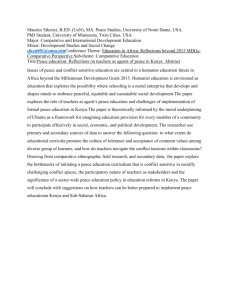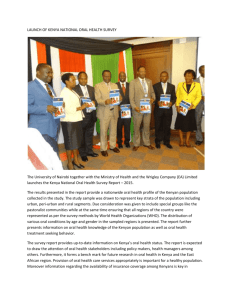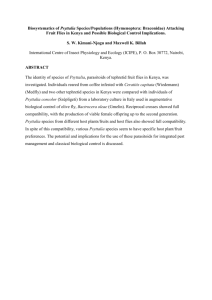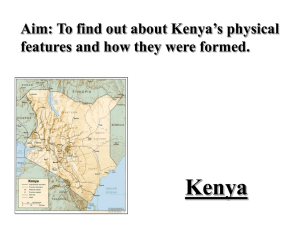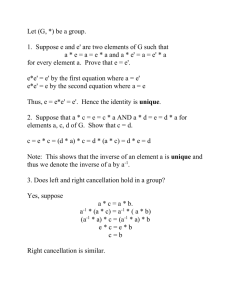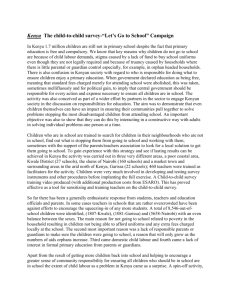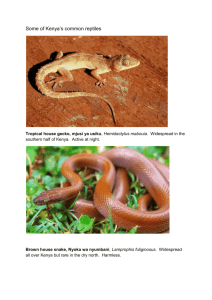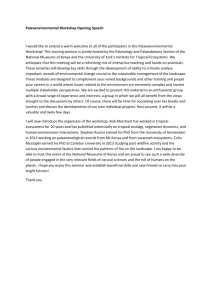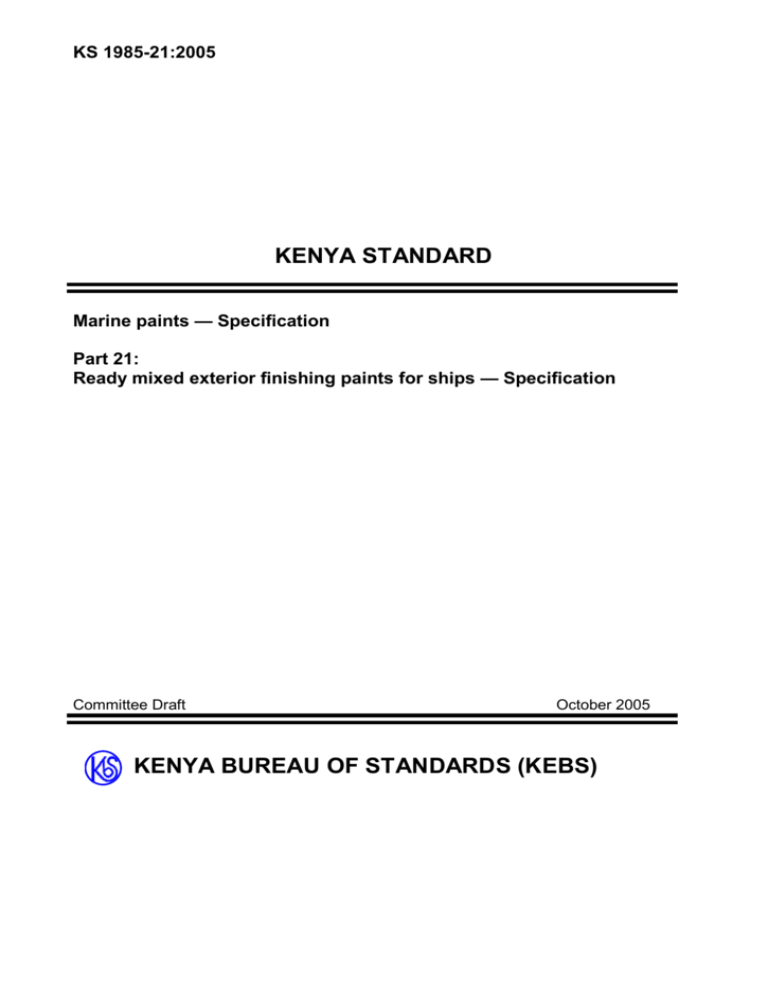
KS 1985-21:2005
KENYA STANDARD
Marine paints — Specification
Part 21:
Ready mixed exterior finishing paints for ships — Specification
Committee Draft
October 2005
KENYA BUREAU OF STANDARDS (KEBS)
KENYA STANDARD
KS 1985-21:2005
TECHNICAL COMMITTEE REPRESENTATION
The following organizations were represented on the Technical Committee:
Jotun paints ltd.
Sadolin Paints (E.A.) Ltd.
Unique supplies.
Kenya Ferry Services
Crown-Berger Ltd.
Government Chemist’s Department
Kenya Ports Authority
SAJCO paints company
Southern engineering company ltd (SECO)
Galaxy paints ltd
Kenya Bureau of Standards — Secretariat
REVISION OF KENYA STANDARDS
In order to keep abreast of progress in industry, Kenya standards shall be regularly reviewed. Suggestions
for improvement to published standards, addressed to the Managing Director, Kenya Bureau of Standards,
are welcome.
© Kenya Bureau of Standards, 2005
Copyright. Users are reminded that by virtue of section 6 of the Copyright Act, Cap. 130 of the laws of
Kenya, copyright subsists in all Kenya Standards and except as provided under section 7 of this act, no
Kenya Standard produced by Kenya Bureau of Standards may be reproduced, stored in a retrieval system in
any form or transmitted by any means without prior permission in writing from the Managing Director.
KENYA BUREAU OF STANDARDS (KEBS)
Head Office: P.O BOX 54974 — 00200-Nairobi, Tel: (+254 020) 502210-19, 502543/45, 603433, 602350/1, 603352,
502543/45, Fax: (+254 020) 503293, E-Mail: info@kebs.org, Web:http://www.kebs.org
Coast Regional Office
Western Kenya Regional Office
Rift Valley Regional Office
P.O BOX 99376 Mombasa
P.O BOX 2949 Kisumu
P.O Box 8111 Eldoret
Tel: (+254 041) 475119
Tel: (+254 057) 22396/23549
Tel: (+254 053) 33151/63377
E-mail: kebs-msa@swiftmombasa.com
E-mail: kebs-ksm@swiftkisumu.com
Fax: (+254 053) 33150
Fax: (+254 041) 472666
Fax: (+254 057) 21814
© KEBS 2005 — All rights reserved
iii
KENYA STANDARD
KS 1985-21:2005
Foreword
This Kenya Standard has been prepared by the Technical Committee on Paints and Allied Products under
the supervision of the Chemical Industry Standards Committee, and it is in accordance with the procedures
of the Bureau.
Ready mixed exterior finishing paint for ships are used in painting system of the weather work areas of ships.
This standard specifies such important parameters like volatile matter, drying times, resistance to natural or
artificial sea water ,salt spray among others.
During the preparation of this standard, reference was made to;
Is 6951— specification for ready mixed paint, finishing, exterior, for ships
Acknowledgment is hereby made for the assistance derived from this source
© KEBS 2005 — All rights reserved
iv
KENYA STANDARD
KS 1985-21:2005
Marine paints — Specification
Part 21:
Ready mixed exterior finishing paints for ships — Specification
1
Scope
This Kenya Standard prescribes the requirements and test methods for ready mixed synthetic exterior
finishing, paint for ships. The material is used in painting system for finishing of the weather work areas of
ships.
.
2
Normative references
The following publications are indispensable in the application of this standard:
KS 161-4, Paints and varnishes — Determination of specific gravity or weigh/litre
KS ISO 4618-1, Paints and varnishes — Terminology
KS 161-5, Methods of test for paint, varnishes, lacquers and enamels-Determination of
volatile and non volatile matter
KS 163, Colours of ready mixed paints
KS 161-2, Methods of test for paint, varnishes, lacquers and enamels-Standard panels
for testing
3
Definitions
For the purposes of this standard, the definitions given in KS ISO 4618-1 shall.
4
Requirements
4.1
Composition
4.1.The material shall be manufactured with ingredients mixed in suitable proportions as given below:
4.1.1 Pigments -The pigments shall consist of minimum 80 percent titanium dioxide when tested in
accordance with KS 03-1101, and maximum 5 percent zinc oxide when tested in accordance with annex A.
4.1.2
Varnish medium It shall consist of a drying oil modified alkyd resin varnish of the long oil type.
4.1.3
Petroleum hydrocarbon solvents and driers shall be added in suitable proportions.
4.2
Odour
The odour of the ready mixed synthetic exterior finishing, paint for ships in the container, during and after
application shall not be abnormally pungent, offensive or disagreeable.
4.3
Condition of material in container
When visually examined ready mixed synthetic exterior finishing, paint for ships shall be free from skins and
lumps. The container shall be free from rust and moulds.
© KEBS 2005 — All rights reserved
5
KENYA STANDARD
KS 1985-21:2005
4.4
Resistance to Natural or Artificial Sea Water - The material, when tested as prescribed in annex B
for 14 days, it shall not show any signs .of break- down and the underlying metal surface shall be free from
corrosion.
4.5
Resistance to Intermittent Salt Spray - The material, when tested as prescribed in KS 161 part 5
for a period of 21 days, the film shall not show signs of blistering, staining, loss of adhesion or creep of
corrosion from scratch
4.6
Lead Content - The material shall contain a maximum of 0.045 % m/m lead when tested in
accordance with KS ISO 3856-1.
4.7
Other requirements
The ready mixed synthetic exterior finishing, paint for ships shall also comply with the requirements given in
the Table 1 below:
Table 1 — Requirements for the ready mixed synthetic exterior finishing paint for ships
Item no
1)
Requirements
2)
Drying time
a) Surface dry
b) Hard dry
Viscosity1at 25oC Pa.s
6 hours, maximum
24 hours, maximum
68 - 72 KU
3)
4)
Solids content, % m/m
Flash point
40, minimum
30 0c, minimum.
5)
6)
Specific gravity at 25 oC
Wet opacity
7)
8)
Finish
colour
9)
light fastness on blue wool
reference scale ,minimum
Flexibility and adhesion on
12mm mandrel
1.10-1.12
75m minimum
Smooth and glossy
Close match with the
colour in the Kebs
universal colour chart
6
10)
1
Characteristic
11)
Scratch hardness using 15N.
12)
Gloss at 600
Test method
KS 909 Annex F
Use the rotation paddle
viscometer
KS 161 Part 5
KS 161 part 17
KS 161 Part 4,
KS 1275 Annex B
Visual examination
KS 163
KS ISO 12040
There shall be no visible
damage or detachment of
film.
KS 161 part 16
No such scratches shall
produce a bare metal
70% minimum.
KS 161 part 19
KS 161- part
Viscosity units.
To change viscosity units from KU (Krebs unit) to mPa.s or cP the following formula shall apply:
Viscosity range of 200-2100 mPa.s (cP)
ln (KU)=1.1187+0.8542*ln (0.1938v +36)-0.0443(ln (0.1938v +36) )2
Viscosity range of 2100-5000 mPa.s (cP)
ln (KU)=1.18118+0.596*ln (0.1938v +36)-0.0206(ln (0.1938v +36) )2
Where KU is the viscosity in Krebs units at 250
and v is the viscosity in mPa.s (cP) at 250
© KEBS 2005 — All rights reserved
6
6
KENYA STANDARD
KS 1985-21:2005
Sampling
4.8
A minimum representative sample of 2L of paint shall be taken randomly from the factory, market or
elsewhere and tested for compliance with the requirements of the standard .
5
Packaging and marking
5.1
Packaging
The paint shall be packed in suitable containers in the following measurers: 20 L, 4 L, 2.5 L, 1 L, ½ L and ¼
L.
5.2
Marking
5.2.1
Marking on the container
Each container shall be marked legibly and indelibly with the following:
a) the words, “ready mixed exterior finishing, paint for ships;
b) name and address of the manufacturer and/or registered trader mark;
d) volume of the material in L;
e)
instructions for correct use; disposal and safety requirement.
f)
Shelf life.
5.2 Marking on the label of the container
a) Date of manufacture
b) Instructions for correct use; disposal and safety requirement
a) Shelf life
b) colour;
© KEBS 2005 — All rights reserved
7
KENYA STANDARD
KS 1985-21:2005
Annex A
(normative)
Determination of zinc oxide
A-0. General
A-0.1 The percentage of zinc oxide in the pigment shall be determined by volumetric method
A-1. Volumetric method
A-1.1 Outline of the Method — A solution of the material in hydrochloric acid is titrated against standard
potassium cyanoferrate (II)* solution and assay calculated.
A-1.2 Reagents
A-1.2.1 Aqueous Ammonia — r. d. 0.9 and 4 N.
A-1.2.2 Hydrochloric Acid — r. d. 1.19 and 4 N.
A-1.2.3 Hydrogen Peroxide Solution — 3 percent.
A-1.2.4 Hydrogen Sulphide — saturated aqueous solution.
A-1.2.5 Potassium Hexacyanoferrate (II) Standard Solution —Approximately 0.05 M. Dissolve 21.0 g of
potassium hexacyanoferrate (II), 300 mg of potassium hexacyanoferrate (III)† and 2 g of anhydrous
sodium carbonate (to stabilize the solution) in water, and dilute with water
to 1 000 ml.
A-1.2.5.1 Standardization of the potassium hexacyanoferrate ( II ) solution
Pipette 25.0 ml of zinc chloride solution into a flask and add 4 N ammonia until a piece of Congo paper
placed in contact with the solution just turns to a pure red colour. Then carefully neutralize the solution by
adding hydrochloric acid 4 N from a dropping bottle and add a few drops in excess until the Congo paper
turns to a permanent bluish-red or reddish-blue colour (pH 3.0 to 1.5). Make up to 150 ml with water, heat
the solution to boiling, and add 10 drops of diphenylamine solution. Immediately titrate the solution with
potassium cyanoferrate solution until the colour turns to a permanent yellow or yellowish green (V 1 ml being
used).
Then back titrate the solution with zinc chloride solution until the colour just turns to blue again (V 2 ml being
used).
The standardization factor F of potassium cyanoferrate (II) solution expressed in grams of zinc per ml is
given by the following formula:
F
0.005(25 V2
V1
A-1.2.6 Zinc Chloride-Standard Solution
Weigh accurately 5.0 g of chemically pure zinc, dissolve in 300 ml of 4 N hydrochloric acid and dilute with
water to 1 000 ml in a volumetric flask.
A-1.2.7 Diphenylamine Solution in Ethanol — 5 g per 100 ml.
A-1.2.8 Congo Paper
A-1.2.9 Lead Acetate Paper
© KEBS 2005 — All rights reserved
8
KENYA STANDARD
KS 1985-21:2005
A-1.3 Procedure
A-1.3.1 Accurately weigh about 1.0 g of zinc oxide dried at 105 ± 2°C. Mix with 15 ml of concentrated
hydrochloric acid and 30 ml of water and evaporate to dryness. Dissolve the residue, by gentle heating if
necessary, in 7 ml of concentrated hydrochloric acid and 30 ml of water. Then add 75 ml
of saturated hydrogen sulphide solution, heat the suspension to a temperature of 40°C and allow to stand for
one hour at this temperature.
A-1.3.2 When the lead sulphide has settled, filter the liquid into a 500-ml volumetric flask and wash the filter
thoroughly with a mixture of 25 ml of the saturated hydrogen sulphide solution, 5 ml of concentrated
hydrochloric acid and 75 ml of water.
Boil the filtrate and washings to expel hydrogen sulphide (test on lead acetate paper). Cool† the solution,
make up to 500 ml with water and shake. Pipette 100 ml of this solution into a flask and add 4 N aqueous
ammonia until a piece of Congo paper, added to the solution, just turns to a pure red colour.
Carefully add 4 N hydrochloric acid from a dropping bottle to neutralize the solution and add a few drops in
excess until the Congo paper turns to a bluish-red or reddish-blue colour ( pH 3.0 to 1.5 ). Heat the solution
to boiling, add 10 g of diphenylamine solution and titrate at once, in a similar manner as described in A1.2.5.1 [V3 ml of potassium cyanoferrate (II) solution and V4 ml of zinc chloride solution being required].
If the zinc content of solution in A-1.2.6 is not exactly 0.005 g/ml an appropriate correction should be applied
to the factor 0.005. If the solution contains iron or manganese, add, after cooling, about 1 ml of 3 percent
hydrogen peroxide and 60 ml of concentrated aqueous ammonia. Make up to500 ml with water and allow the
solution to stand for two hours.
Then filter through an absolutely dry filter and funnel. Discard the first 10 to 20 ml of the filtrate. Collect the
remainder in a dry flask, remove 100 ml by means of a pipette and boil this to expel ammonia. Then acidify
this solution with hydrochloric acid 4 N until a piece of Congo paper turns to a bluish-red or a reddish-blue (
pH 3.0 to 1.5 ). Heat the solution to boiling, add 10 drops of diphenylamine solution and immediately titrate
the solution in a similar manner as described in A-1.2.5.1 (V3 ml of potassium cyanoferrate solution and V4
ml of zinc chloride solution being used). For calculation, see under A-1.4.
A-1.4 Calculation
Zinc oxide, percent by mass = 6.223( FV3 0.005V4 )
100
M
Where;
F = standardization factor of potassium cyanoferrate (II) solution,
V3 = volume in ml of potassium cyanoferrate (II) solution used,
V4 = volume in ml of standard zinc chloride solution used,
M = mass in g of the test sample.
A.4.1
.
Report whether viscosity has doubled at 25 0c within six hours.
© KEBS 2005 — All rights reserved
9
KENYA STANDARD
KS 1985-21:2005
Annex B
(normative)
Resistance to natural or artificial sea water
B-O General
B-0.1 Outline of the Method
The painted panel is immersed in natural or artificial sea water for specified period and paint film examined
for any deterioration.
B.1
composition of natural sea water
B-l.1 The natural sea water shall have a pH of 7.9 to 8.3 and a chlorinity of not less than 17 parts and salinity
of 31 parts per l000.
B.2
composition of artificial sea water
B-2.1 Dissolve the specified amounts of the following salts and make up with freshly distilled water to give
1000 ml of the solution:
Salt
Mass(g)
Sodium chloride (NaCl)
23.476
Magnesium chloride (Mg Cl2 )
4.981
Sodium sulphate ( Na2 SO4 )
3.917
Calcium chloride (Ca Cl2 )
)
Potassium chloride (KC1)
1.102
Sodium bicarbonate (NaHCO4 )
0.192
Potassium -bromide (KBr)
0.096
Boric acid ( H2B03 )
0.026
Strontium chloride ( SrCl2 )
0.024
Sodium fluoride ( NaF)
0.003
34.481
0.664
Water to make 1000.000ml
B-3 PROCEDURE
B-3.1 Clean a burnished mild steel panel that coresponds to KS 03-161 Part 2.Paint the panels on both
sides with a single coat of a primer and dry for 48 hours. Then apply a single coat of the material conforming
to this standard. Allow the panel to dry for 7 days.
B-3.1.1 Seal the edges with a protective coating to a depth of 6 mm by immersing the panel in molten
paraffin wax
.
B-3.2 Immerse the test panel in a natural or artificial sea water at room temperature for 14 days through
which air is passed gently and continuously. Examine the panel at the end of the period for signs of
© KEBS 2005 — All rights reserved
10
KENYA STANDARD
KS 1985-21:2005
deterioration of the paint film and for any corrosion of the substrate after removing carefully a portion of the
paint system with a suitable paint remover.
.
© KEBS 2005 — All rights reserved
11

